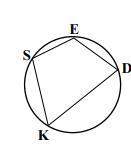
Mathematics, 05.02.2021 02:10 jaydenrenee111902
(ANSWER ASAP) *Still Unanswered* Lines a & b represent a system of linear equations. Line a passes through the points (1,3) and (3,1). Line b passes through the point (-1,0). Which statement must be true? 1, 2, 3, or 4?
1) If line b passes through the point (-2,1) then there are infinitely many solutions to the system of equations because the slopes of the lines are the same.
2) If line b passes through the point (0,1) then there is more than one solution to the system of equations because the lines are perpendicular.
3) If line b passes through the point (1,3) then there are infinitely many solutions to the system of equations because line a also passes through the point (1,3)
4) If line b passes through the point (1,-2) then there is no solution to the system of equations because the lines are parallel.

Answers: 3


Other questions on the subject: Mathematics

Mathematics, 21.06.2019 14:30, Melymarrupe1345
Name the quadrilaterals that have four equal sides.
Answers: 1

Mathematics, 21.06.2019 17:00, Zykuko
Asays "we are both knaves" and b says nothing. exercises 24–31 relate to inhabitants of an island on which there are three kinds of people: knights who always tell the truth, knaves who always lie, and spies (called normals by smullyan [sm78]) who can either lie or tell the truth. you encounter three people, a, b, and c. you know one of these people is a knight, one is a knave, and one is a spy. each of the three people knows the type of person each of other two is. for each of these situations, if possible, determine whether there is a unique solution and determine who the knave, knight, and spy are. when there is no unique solution, list all possible solutions or state that there are no solutions. 24. a says "c is the knave," b says, "a is the knight," and c says "i am the spy."
Answers: 2

Mathematics, 21.06.2019 18:30, leobaut6145
Apsychology student wishes to investigate differences in political opinions between business majors and political science majors at her college. she randomly selects 100 students from the 260 business majors and 100 students from the 180 political science majors. does this sampling plan result in a simple random sample? why or why not? no, because each group of 200 students in the sample does not have the same chance of being selected. yes, because each group of 200 students in the sample has the same chance of being selected. no, because each individual student does not have an equal chance of being selected. yes, because each individual student has the same chance of being selected.
Answers: 1

Mathematics, 21.06.2019 18:30, thefandomarmy24
Factor k2 - 17k + 16. a.(k - 2)(k - 8) b.(k - 1)(k + 16) c.(k - 1)(k - 16)
Answers: 1
You know the right answer?
(ANSWER ASAP) *Still Unanswered* Lines a & b represent a system of linear equations. Line a pass...
Questions in other subjects:

Physics, 19.10.2019 09:10

History, 19.10.2019 09:10


History, 19.10.2019 09:10


History, 19.10.2019 09:10

History, 19.10.2019 09:10

Computers and Technology, 19.10.2019 09:10

History, 19.10.2019 09:10




